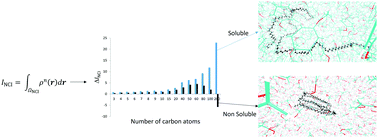Towards a predictive model for polymer solubility using the noncovalent interaction index: polyethylene as a case study†
Abstract
In this work we present the development of a novel, quantitative solubility descriptor based on the non-covalent interaction index. It is presented as a more insightful alternative to Hansen's solubility parameters and the COSMO model to assess and predict polymer solubility in different solvents. To this end, we studied the solvation behaviour as a function of the chain length of a single chain of arguably the most simple polymer, polyethylene, in anisole (solvent) and methanol (poor solvent) via molecular dynamics simulations. It was found that in anisole the solute maximized its interface with the solvent, whereas in methanol the macromolecule formed rod-like structures by folding on itself once the chain length surpassed a certain barrier. We assessed this behaviour – which can be related to solubility – quantitatively and qualitatively via well-known descriptors, namely the solvation free energy, and the solvent accessible surface area. In addition, we propose the non-covalent interaction (NCI) index as a versatile descriptor, providing information on the strength, as well as the nature, of the solute–solvent interactions, the solute's intramolecular interactions and on the solute's conformation, both qualitatively and quantitatively. Finally, as a quantitative measure for solubility, defined in this context as the solute's tendency to maximize its interactions with the solvent, we propose two new NCI-based descriptors: the relative integrated NCI density and the integrated NCI difference. The former represents the quantitative difference in solute–solvent interactions between a fully extended coil and the actual conformation during simulation and the latter the quantitative difference between the intermolecular (solute–solvent) and the intramolecular (in the solute) non-covalent interactions. The easy interpretation and calculation of these novel quantities open up the possibility of fast, reliable and insightful high-throughput screening of different (anti)solvent and solute combinations.



 Please wait while we load your content...
Please wait while we load your content...